4—
Rhythmic Structure
Prototypes
Most of the music examined thus far conforms to what has loosely been termed a block structure . Within such a framework, two or more blocks of relatively heterogeneous content are repeatedly and often abruptly juxtaposed. A simple illustration—simple as design only—can serve here as a useful departure.
In Example 37 the opening section of Agon 's "Bransle Gay" is reproduced in condensed form. As is apparent, the general outline corresponds to that at no. 46 in the "Ritual of Abduction" and, indeed, to the more extended format of the "Evocation." Two blocks, labeled A and B, alternate with one another, the first of these pacing successive appearances of the second. Here, of course, each block remains stable in duration. But even within the limitations of such a framework, the modification is subtle and typical. At m. 4, motive a7 is shortened to a5, while in the restatement of Block B at mm. 7–10 the motivic succession is reshuffled, a5–c7 now preceding a7–b5.[1] Of special note is the fixed registral and instrumental identity of
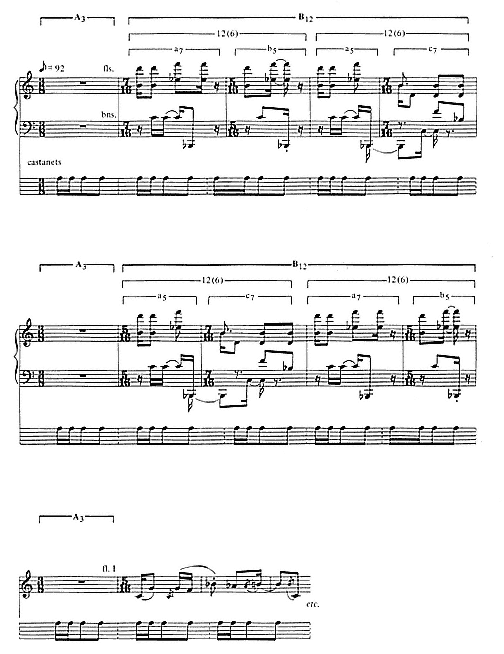
Example 37:
Agon ("Bransle Gay")
each block or motivic unit: upon successive repeats, content remains fixed. And this is true even when, at mm. 7–10, the initial motivic order is reshuffled.
Nearly all the dance movements of The Rite conform in one way or another to the features and implications of this construction. Most conspicuous in Part I are the "Ritual of Abduction" and the "Ritual of the Rival Tribes" (both presently to be discussed), and, in Part II, the "Glorification of the Chosen One," along with the "Evocation" and the opening section of the "Sacrificial Dance" (as discussed already). The underlying principles of this structure, henceforth designated rhythmic Type I, may be summarized as follows.
1. Foreground metric irregularity; an irregular or shifting meter.
2. Two or more blocks of contrasting material alternate with one another in constant and often rapid juxtaposition. A block may consist of a single measure (which will correspond to the repeat of a single motivic unit or "cell") or of several measures (which will reflect the subdivision of a lengthier strand of material into smaller motivic units or "cells").
3. The irregular meter records the diverse lengths of the blocks, their internal "cellular" subdivisions, and subsequent extensions and contractions.
4. Upon successive restatements, blocks and their internal subdivisions remain stable in content. Moreover, within each block the horizontal lines or parts share the same rhythmic-metric periods (cycles or spans) as defined by the shifting meter; they proceed en masse , as it were, with no imitative dialogue or exchange. Thus, too, sharing the same periods as defined by the meter, these lines or parts are synchronized unvaryingly in vertical or harmonic coincidence; from one statement or repeat to the next, the vertical disposition is always the same. Blocks thus convey little internal sense of harmonic progress, such progress being possible only between blocks. And even the latter requires qualification, since, within the larger dimensions of a juxtaposition, the same blocks, modified or reordered, are always preceding or succeeding one another.
5. It follows from the above that the invention presupposed by Type I is fundamentally rhythmic in conception. A sense of "development," of progress, change, or movement, derives in large part from the lengthening, shortening, or reshuffling of the blocks and their internal subdivisions upon successive repeats.
A second type of construction, henceforth designated rhythmic Type II, is, in contrast, most often characterized by a steady meter. Structures adhering to this second type tend often to emerge as separate blocks at the end of extended movements, as with the passages at nos. 28–30 and 31–37 in the "Augurs of Spring," where reiterating fragments are brought together in a climactic fashion. Thus, too, the whole of the "Procession of the Sage," conforming in all particulars to Type II,
surfaces without interruption as the climactic section of the preceding "Ritual of the Rival Tribes." On the other hand, the "Dance of the Earth" is an independently realized Type II structure, one of the lengthiest of its kind in Stravinsky's music. The general features of Type II are as follows.
1. Foreground metric regularity; most often, a steady meter.
2. The construction consists of a superimposition of two or more motives that repeat according to periods, cycles, or spans that are not shared but vary independently of, or separately from, one another. The periods of these reiterating fragments may be stable (a motive whose duration is always four quarter-note beats, for example), or unstable (always changing in duration). (Pauses or rests that follow the repeat of a motive are always counted as part of its period.) As noted, the construction may emerge as one of the several blocks within a larger block structure or, in climactic fashion, as the concluding section to an extended movement.
3. The steady meter generally records the stable periods of one of the superimposed, reiterating fragments. In the "Procession of the Sage" at nos. 64–70, the








4. As with Type I, the reiterating fragments remain fixed registrally and instrumentally, with no imitative or developmental dialogue or exchange. But since, as indicated, these fragments repeat according to periods that vary independently of one another, they produce a vertical or harmonic coincidence that is inconstant, constantly changing. But here, too, there are static implications, since this inconstancy in vertical coincidence is effected by reiterating fragments which, although repeating to independent periods, remain fixed in content.
5. It follows from the above that the invention presupposed by Type II is fundamentally rhythmic in conception. A sense of "development" has in large part to do with the synchronization and non-synchronization of the stable or unstable periods as defined by the reiterating fragments and with the vertical or harmonic implications of these shifts in alignment.
The true distinction between these types of rhythmic structure can best be gauged as it relates to the motivic or fragmental repetition. With the first of these
two types, the individual motives, lines, or parts share the same irregular periods, as defined by the shifting meter. They proceed, as indicated, en masse and are hence synchronized unvaryingly in vertical or harmonic coincidence. Thus, in the opening block of Les Noces (Example 23 in Chapter 3), all the parts move in unvarying synchronization with the stressed, over-the-barline D-E succession, while the xylophone punctuates always, and only, the one particular D that, over the bar line, is succeeded by E as the point of departure and return. And with the initial B statement in the "Evocation" (Examples 27–34 in Chapter 3), all the parts unvaryingly coincide with the punctuation of C and its inflection D—or, in chordal terms, with the punctuation of (A-C-G-A-C-E) and its (G-D-G-B

Even more critical from the standpoint of these distinctions is the play of fixed metric identity and displacement, the theme to which the present discussion has in large part been devoted. Actually, both types partake of the play or double edge. The difference is that with Type II felt displacement is graphically a part of the invention. The steady meter immediately exposes changes in the metric identity of the reiterating fragments, changes which, with Type I, are concealed by the foreground irregularity. On the other hand, the opposite side of this coin, fixed metric (or rhythmic) identity in repetition, is equally a part of Type II. But in place of Type I's shifting meter, fixed stress and slur markings are applied to the repeats of a reiterating fragment, which intone a counteracting sameness in identity irrespective of placement or subsequent displacement in relation to the steady meter. An account of the "Ritual of the Rival Tribes" and its succeeding "Procession of the Sage" can further explain these interactions.
"Ritual of the Rival Tribes"
As is shown below in Chart 2, the uninterrupted stretch that begins with the "Rival Tribes" at nos. 57–67 and extends through the whole of the "Procession" to "The Sage" at no. 71 divides into three large sections. As is evident, the construction in the first of these sections adheres to Type I; four contrasting blocks of material are
| ||||||||||
placed in abrupt juxtaposition to one another.[2] Indeed, in the original stage action, Blocks A and B accompanied the individual movements of two contending tribes, while Block C accompanied a type of tribal "clash." In Section II, extended repeats of Block C alternate with a new (E


The block structure of Section I is outlined in Example 38. In quarter-note beats, the brackets record the varying lengths of the four alternating blocks, their internal subdivisions, and subsequent modifications in block succession. Note the prolonged absence of Block C at nos. 58(+6)-62; it is eventually reclaimed at no. 62 as the principal block of Section II. Block D is in turn ignored in Section II, with its principal fragment retrieved at the beginning of Section III.
Attention in Example 38 is focused primarily on Block B and its two motivic units, a and b. There are five B statements in Section I, the first of which, at no. 57 + 2, introduces an a4–b3 motivic order as a point of departure. This is modified at no. 58 by a 4 + 2 delineation, which is reinforced at no. 59 by back-to-back 4 + 2 statements, the second of which features a transposition by a major third. The initial 4 + 3 division returns at no. 59 + 5 but is then followed, after an extended introduction of the new lyrical Block D, by a 4 + 4 + 2 statement. The specifications are summarized in Chart 3.
Obviously, the invariant element in these B statements is motive a, which retains the stable duration of four quarter-note beats. In contrast, motive b, varying between three and two beats, is mobile and as such determines the modification of subsequent B statements. Moreover, the mobility of motive b is in no way patterned. Yet, following the back-to-back 4 + 2 statements at no. 59, the restoration of its original 4 + 3 count at no. 59 + 5 may be felt as a welcome return to its—at this point—nearly forgotten point of departure.
Notice, too, that upon successive restatements, the horizontal motives, lines, or parts are fixed registrally in relation to one another. In accord with most structures adhering to Type I, these parts share the same irregular periods as defined by the shifting meter, so that the vertical disposition—the harmony or vertical alignment—remains unchanged from one statement to the next. (The disposition for Block B is given only for the initial two statements in Example 38; subsequent reentries do not deviate from this model.)
[2] The block labeled D in Section I refers to the passage at no. 43; the material here is derived from Block B in the "Rival Tribes." Recall that, according to the chronology of the sketchbook, the music of the "Rival Tribes," "Procession," and "Sage" was composed before that of the "Abduction."
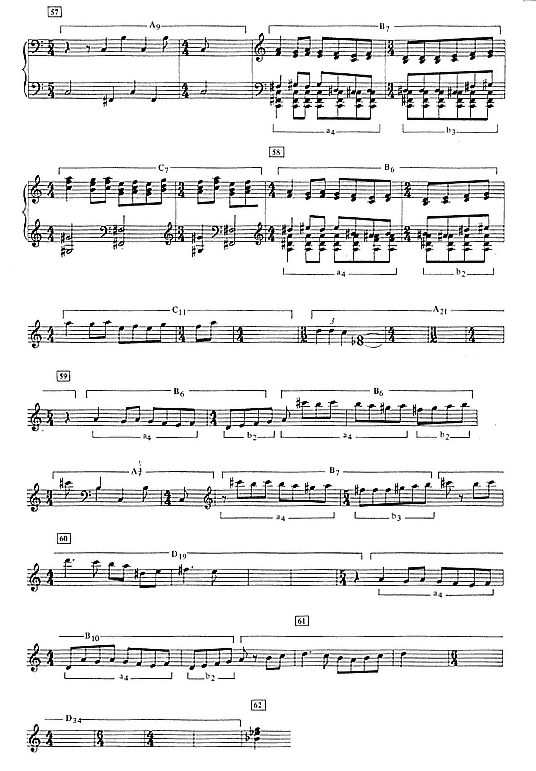
Example 38:
"Ritual of the Rival Tribes"

Chart 3:
"Rival Tribes"
In Section I, the quarter-note is the tactus, with a tempo marking of 168. And since the meter shifts throughout by way of the tactus, perceptual adjustments are made with greater ease than in those instances where, as examined earlier, a dissection by smaller units of beat leads to an actual disruption of the pulse. Nonetheless, that Block B's initial 4 + 3 count at no. 57 + 2 might be heard and understood as an abbreviation of a "rational" 4 + 4 count (with, in other words, Block C entering a quarter-note beat too soon at no. 59 + 4) seems by no means farfetched. For it does appear that, pursuant to the higher-level duple implications of a steady

"Procession of the Sage"
Stretching from no. 64 in the "Rival Tribes" to the end of the "Procession," a condensed version of the climactic Section III is shown in Example 39. There are three principal fragments: a G-F-E-D motive in the strings at nos. 64–66, the G







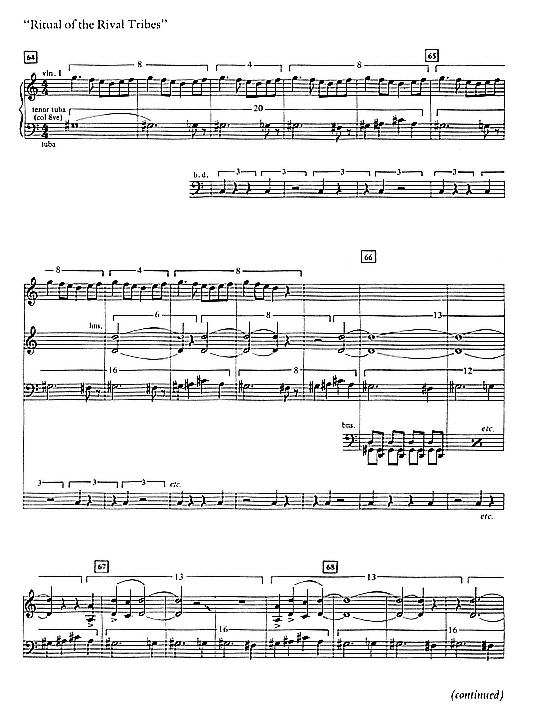
Example 39

Example 39
(continued)
Examples 5 and 6.) In addition, there is an important G

The construction of Section III conforms to Type II; the three fragments in the strings, tubas, and horns repeat according to periods, cycles, or spans that vary independently of, or separately from, one another. And of special note is the extreme mobility of the periods defined by each of these fragments. For not only do the periods vary independently of one another, they are in themselves unstable, being of unequal duration. (Compare, in Example 39, this instability with the spans of the bass drum motive, spans which, although varying separately from those of the three principal fragments, define a stable duration of three quarter-note
beats.) Thus the duration of the horn's D or A-D-C-D reiteration, detached by rests until no. 70, is constantly altered. Bracketed in Example 39, the first appearance, at no. 65 + 2, spans six quarter-note beats; the second, at no. 65 + 3, eight beats; the third, at no. 66, thirteen beats (this is repeated twice); and the sixth, at no. 68 + 2, a full seventeen beats in a final stretching in this gradual expansion. And while, beginning at no. 64, the conflicting periods of the tuba fragment divide into "equal" or "rational" groupings of four and eight quarter-note beats in support of the steady






All the same, as this massive block draws to a close at no. 70, the mobility is eventually curbed. The periods of the horn's A-D-C-D reiteration reach a stable duration of eight quarter-note beats, while, at no. 67, those of the tuba fragment attain a sequence of three G






But beyond these statistics, the conflict at nos. 64–71 stems far more readily from the play of fixed metric identity and displacement. As with most passages adhering to Type II, a steady meter is imposed: a





Nonetheless, in direct opposition to these displacements, the articulation of the A-D-C-D fragment remains unchanged. Irrespective of A-D-C-D's placement relative to the


to the initial identification might here begin to doubt the stability of the





"Ritual of Abduction"
As with the "Rival Tribes" and the "Procession," the block structure of the "Ritual of Abduction" can be divided into three principal sections as shown below in Chart 4. Here, however, the construction of each section conforms in one way or another to Type I.
Focusing for the most part on Block A, Example 40 is taken from Sections I and II. Notice that while the "Abduction" has a






Earlier, in connection with Example 14 in Chapter 3, attention was drawn to the principal fragment of Block A at nos. 37 and 40 and to its subsequent dissection at no. 46. Introduced within a


| ||||||||

Example 40:
"Ritual of Abduction"
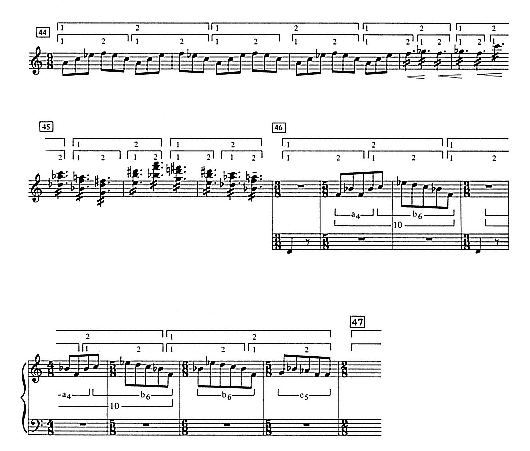
Example 40
(continued)
with a tempo marking of 132) are disturbed. And while the listener's attention might at first be directed toward some form of accommodation with the preestablished dotted quarter-note pulse, the persistence of the irregularity will more than likely force an abandonment of this effort—and of the established pulse in favor of the almost impossibly rapid eighth-note beat. This, in brief, is the nature of the disturbance.
Of course, as this disruptive stretch draws to a close at no. 47, the




Example 41:
"Ritual of Abduction" (re-barred)
There are several reasons for this. First, the punctuation of F on any beat other than a metrically accented one is bound to seem strange. Listeners bent on accommodation are apt to spot the punctuating F as an anchor, as a downbeat or metrically accented pitch, and to regulate the surrounding material accordingly. Second, and perhaps more especially, the metric identity of the reiterating fragment as rebarred in Example 41 fails to correspond to the initial identities as introduced at nos. 37 and 40. In other words, while the metric identity of the motive b6 (which is isolated as a separate entity at no. 40 + 3) remains constant, this fixed identity fails to conform to the earlier announced identities in relation to the steady


As is shown above in Example 40, Block A's reiterating fragment encompasses two separate identities. And in each of the block statements at nos. 37 and 40 these are presented successively; the motivic unit labeled b6 is repeated and shifted forward by an eighth-note beat. Thus, too, transposed to the level designated by no. 46, these two identities (or placements in relation to the




More simply, of course, these separate identities are part of a pattern of cyclical displacement. Taking as model the initial a4–b6 motivic order, the sum of ten eighth-note beats misses nine by one. Hence, as outlined in Examples 42a–42c, the overlapping tens are part of a sequential displacement on the part of the reiterating fragment. Example 43 offers a somewhat different view of these implications, where the sum of seven beats misses six by one. Following the third placement in the third and fourth measures of this example, a fourth shift forward would merely
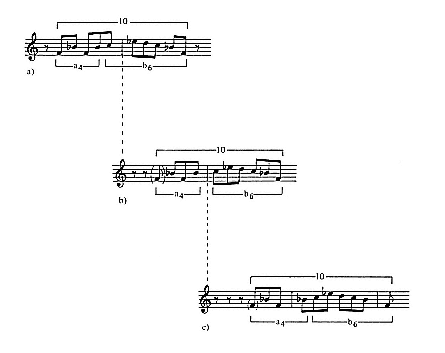
Example 42:
"Ritual of Abduction"

Example 43:
"Ritual of Abduction"
return the cycle to its point of departure. (Note that the third and final placement in Examples 42c and 43, ignored at nos. 37 and 40, corresponds to that proposed and rejected in connection with the targeted re-barring of no. 46 in Example 41.) The point of these illustrations is that in approaching the climactic passage at no. 46, the disruption will entail not merely the prior metric identity of a reiterating fragment but a patterned cycle of displacement in relation to the steady


Of course, the fact that the a4–b6 motivic order misses the sum of nine by one beat does eventually become the bone of contention, at no. 46. Severed from its initial


a4–b6 becomes isolated as a fixed component. Framed by the punctuation of F, which retains the dotted quarter-note beat as a stable duration, the sum of ten becomes "irrational" and hence disruptive in character. Further along, in the fourth, fifth, and sixth bars at no. 46, an elided a4–b6 order is followed by repeats of b6, a succession deceptively mirroring that at nos. 37 and 40.
Indeed, efforts at accommodation are likely to be subject to the following conditions: (1) that the punctuations of F fall on metrically accented dotted quarter-note beats, and (2) that subsequent repeats of motive b6 conform to one of the two identities exposed earlier at nos. 37 and 40 and outlined in Examples 42a and 42b. Both conditions are met by the re-barring proposed in Example 44. Thus, if the initial F of the a4–b6 motivic order is heard and understood as falling not on the dotted quarter-note beat but, as shown, on the eighth-note immediately preceding the beat (with a slight pause allotted to the initial F-punctuation), then the entire stretch until the final

But as an ironic twist to this conservative reading, the re-barred version of Example 44 is without the convenience of a target. Having shifted the climactic stretch backwards by an eighth-note beat, the proposed


As a final item here, the somewhat curious nature of the composer's initial notations for the music of the "Abduction" should be noted. For, as is shown in Example 3b in Chapter 1, the first entry for this movement appears already on page 7

Example 44:
"Ritual of Abduction" (re-barred)
of the sketchbook, a page that is ostensibly devoted to the "Spring Rounds." And this entry shows the sum of ten divided into two "irrational" bars of






